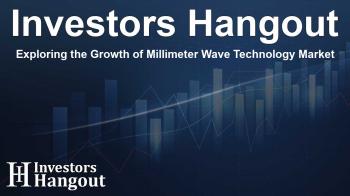Exploring the Growth of Millimeter Wave Technology Market

Millimeter Wave Technology Market Overview
The global landscape of millimeter wave technology is poised for significant growth, aiming for a revenue of USD 14.8 billion by 2031, with a compound annual growth rate (CAGR) of 9.5% expected through 2024 to 2031. This market is increasingly relevant as our society becomes more reliant on high-speed data transmission.
Key Factors Driving Growth
One of the pivotal factors fueling the boom in millimeter wave technology is the explosive growth in demand for high-speed, data-intensive communication networks. The advent of 5G and other advanced wireless technologies is at the forefront of this rising trend. As more sectors incorporate these communication advancements, an unprecedented level of connectivity is made possible, revolutionizing everyday interactions and operations.
Rising Demand for High-Speed Data Transfer
With mobile data traffic increasing at an exponential rate, the need for robust and efficient communication systems is evident. Millimeter wave technology facilitates rapid data transfers, essential for uninterrupted streaming and the management of IoT devices, propelling investments in telecommunications infrastructure. This demand not only fosters advancements in technology but also supports the growth of smart cities globally.
Innovations in Automotive Technologies
In the automotive industry, there is a notable integration of millimeter wave technology, primarily to enhance safety systems in vehicles. This encompasses radar technology for accurate navigation and collision avoidance, making vehicles safer and paving the way for the future of autonomous driving. Companies involved in automotive electronics are likely to experience thriving business opportunities as this technology continues to evolve.
Military and Defense Investments
The military sector's continual investment in advanced communications for secure and fast relay of information is another growth driving factor. The unique capabilities of millimeter wave technology provide superior bandwidth and minimal interference, making it an attractive option for modern defense applications. This focus on enhancing capabilities is a catalyst for growth, giving rise to numerous opportunities for technology developers and defense contractors.
Challenges Facing the Market
While there are numerous benefits tied to the use of millimeter wave technology, several challenges remain that could potentially hinder its implementation. High infrastructure costs are a primary concern, as substantial investments are required to build the appropriate facilities and equipment for operability.
Signal Attenuation Issues
Additionally, the nature of millimeter wave signals makes them susceptible to attenuation. They struggle to penetrate obstacles such as buildings or trees, resulting in connectivity issues, particularly in urban areas. Addressing this challenge often necessitates increased network density and extensive installations, which can drive costs up for service providers.
Regulatory Spectrum Limitations
Another barrier influencing market expansion is the limited availability of spectrums required for 5G capabilities. The intensity of competition among companies for these spectrums can slow down progress and hinder new project developments.
Regional Insights
North America stands out as a leader in the millimeter wave technology market. The region benefits from early adoption of 5G technologies coupled with substantial R&D investments. The robust support from stakeholders in the tech industry and a thriving defense sector only enhance this region's strategic position. With these developments, North America could set the standard for global advancements in millimeter wave solutions.
Market Segment Analysis
According to verified research, the Millimeter Wave Technology Market encompasses various segments. These include components such as communication and networking aspects, frequency bands, licensing types, product categories, and end-user applications.
Key Players in the Industry
Market leaders like Qualcomm Technologies, Inc., NEC Corporation, and Keysight Technologies are instrumental in shaping the future trajectory of the millimeter wave technology sector through continual innovation and competitive strategies.
Frequently Asked Questions
What is the projected growth of the millimeter wave technology market?
The market is expected to grow at a CAGR of 9.5%, reaching around USD 14.8 billion by 2031.
What drives the demand for millimeter wave technology?
The rising need for high-speed data transmission, especially with the advent of 5G networks, is a key factor driving demand.
In which industries is millimeter wave technology gaining traction?
This technology is crucial in telecommunications, automotive, military applications, and IoT, among others.
What are the challenges faced by the millimeter wave technology market?
Challenges include high infrastructure costs, signal attenuation, and limited spectrum availability.
Who are the key players in the millimeter wave technology market?
Significant companies include Qualcomm Technologies, Inc., NEC Corporation, and Keysight Technologies, among others.
About Investors Hangout
Investors Hangout is a leading online stock forum for financial discussion and learning, offering a wide range of free tools and resources. It draws in traders of all levels, who exchange market knowledge, investigate trading tactics, and keep an eye on industry developments in real time. Featuring financial articles, stock message boards, quotes, charts, company profiles, and live news updates. Through cooperative learning and a wealth of informational resources, it helps users from novices creating their first portfolios to experts honing their techniques. Join Investors Hangout today: https://investorshangout.com/
Disclaimer: The content of this article is solely for general informational purposes only; it does not represent legal, financial, or investment advice. Investors Hangout does not offer financial advice; the author is not a licensed financial advisor. Consult a qualified advisor before making any financial or investment decisions based on this article. The author's interpretation of publicly available data shapes the opinions presented here; as a result, they should not be taken as advice to purchase, sell, or hold any securities mentioned or any other investments. The author does not guarantee the accuracy, completeness, or timeliness of any material, providing it "as is." Information and market conditions may change; past performance is not indicative of future outcomes. If any of the material offered here is inaccurate, please contact us for corrections.
